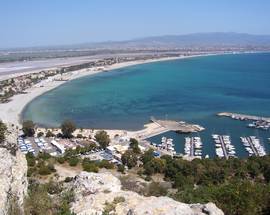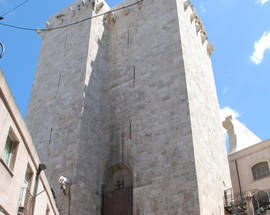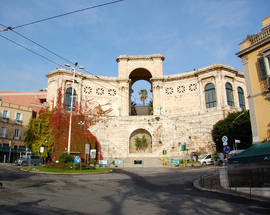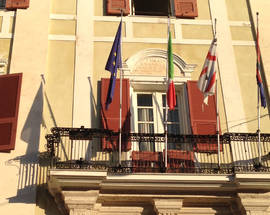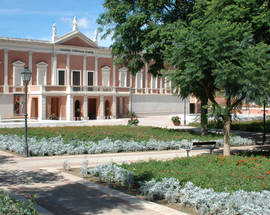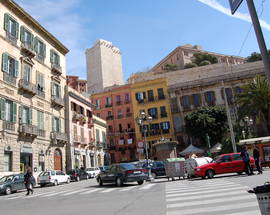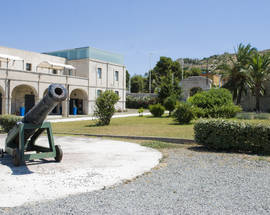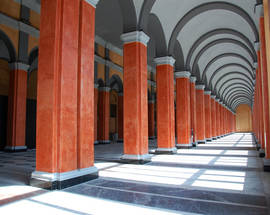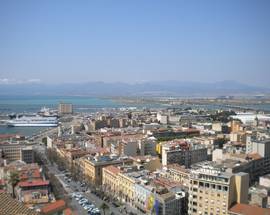City of light and wide skies; long lunches and longer siestas; of days on the beach, surfing and sailing. Then after all that sunlight and laughter what, as the song asks, ‘comes after?! Why!’ Cagliari's kaleidoscopic nightlife. This is an exciting place to live, and an awesome one to visit.
A generation ago hardly anyone came to Cagliari unless they had to. Now they're queueing up - cruise liners jostle each other to be let into port; jumbo jets stack up across the arc of blue above the gulf of Angels: the railway and bus stations pullulate; taxi drivers need to change their cars every two months. For though hoteliers and other beneficiaries of the tourist trade seem, like farmers, to enjoy being pessimistic, the numbers of visitors edge up year by year. At the same time, Cagliari's facilities and services are able to more than match this growing demand.
While the 'underlying causes' for this increased influx are doubtless myriad and mysterious (underlying causes invariably are), the essential answer is perfectly straightforward. After its long sleep (Rome's patricians and rich merchants loved wintering in Sardinia), Cagliari has awoken to its potential as a holiday destination, rather than merely a port of call.
What of course hasn't - and couldn't have! - changed are Cagliari's basic characteristics: its climate, geographical position and population. Reflected off the sparkling (and clean) waters of the town beach, Poetto, or sliding with the passing hours over the vistas of stone and terracotta of the old town, southern Sardinian sunlight caresses land and sea alike. Seldom too hot to be unbearable, seldom absent long enough to reach for a second scarf.
The same sunlight magically enhances and nuances colour. Stuccoed façades deep orange at breakfast time fade at noon to pale beige then glow again, now though like a ripe apricot, while the shadows lengthen as the sun dips behind the mountains of Capoterra across the bay. Roofscapes too form, dissolve, re-form: pink to tawny, to parched eggshell grey, to plum red, to burnt umber.
Not a city of parks or fountains - not, as I once fondly imagined, a sort of Granada-by-the-sea - Cagliari is at last taking good care of its gardens and the four of five tree-lined thoroughfares which traverse and encircle the older parts of the city.
Punctilious pruning and pollarding have become regular municipal activities. But green areas they are. A ramble around the Botanical Gardens, in viale Sant'Ignazio da Laconi, just below the Roman Amphitheatre, is an educative as well as relaxing way to spend a couple of slow hours. Or in the early evening, after showering and changing, you could promenade along the well laid paths of the Public Gardens (Giardini Pubblici, at the top of viale Regina Elena), before strolling down on your way to an aperitif and dinner. If, however, you fancy a more adventurous walk, then go to Monte Urpinu, several acres of carefully tended pine woods (between via Scano and viale Europa). Here, despite its walkways, two artificial lakes and clipped hedges, one could, especially in its remoter upper reaches, really be several miles instead of half a one from so-called civilization. Nature mightn't exactly impinge on Cagliari; it does now at least have a place amongst the town's hectares of bricks and cement.
For many of course, inhabitants as well as visitors, Cagliari suggests the seaside. Beaches not streets; swimming not walking; bikinis and flip-flops, salt-stiff towels drying on the hotel balcony after a day of sun cream and water sports. And if this is what you principally want from a holiday, Cagliari is your Mecca. The five sandy miles of the broad, gently-sloping Poetto beach (15 minutes by bus from via Roma) with its quiet waves, jolly bars and reasonably priced lidos and bathing establishments is the obvious choice. At the town end of Poetto, and well worth a visit, is the pretty boating marina - all sparkling water, wheeling gulls, bobbing yachts and dinghies, a tiny enclave of fishing smacks: the haunting yet wholesome tickity-tackity of rigging dancing and flickering in the soft wind and glancing sunlight.
Another beach that one can easily reach from the landside is Calamosca (plus several coves and inlets, like Cala Fighera, in the lea of the Sella del Diavolo, you need a boat to visit or else a somewhat risky walk up and down the cliffs), very much a locals' bathing spot, and beautifully sheltered when the mistral wind is blowing hard. Coastal Cagliari, as can be noted whether one arrives by air or sea, also means rocky shorelines, soaring cliffs and deserted headlands, especially the area which sweeps down from the Capo Sant'Elia lighthouse to the borgo of the same name. This district - with a startling 1960s church, opened by Pope Paul VI, and the former Lazzaretto hospital, now providing space for art exhibitions and theatre - is also host to a rumbustious Sunday morning food and flea market.
Talk of marketing draws one back to the town centre, where shops and stalls inevitably comprise a fundamental component. Cagliari's shopkeepers as a rule are not content merely to ‘keep’: they propose their wares. Fortunately though, they wait to do this until you are inside their emporia, unlike their pushier counterparts in, say, Naples or Rome, who will clamour for your custom out on the pavement. You don't risk being a victim of such off-putting selling techniques when out and about in Cagliari, an altogether more laid back experience. And one too that gives you the chance to meet and observe the local citizenry.
Except for the inevitable grumpy kins with a communication problem, people in Cagliari are polite and friendly - pleased, for example, to answer a puzzled tourist's queries, and probably greatly amused to gossip later about their encounter! Cagliaritani look good too. With their dark radiant complexions, neat well-proportioned physiques, Pepsodental smiles and possessed of a natural grace, gravitas and poise (as D.H. Lawrence noted when he visited Sardinia ninety years ago) wandering around Cagliari is as satisfying aesthetically as it is socially.
While Cagliari can be a feast for the eye and the soul, it is also for the nose. Cagliari likes its food, is prepared to pay for it, and is adept at cooking it. This means lots of delicious smells and aromas, and not only as you pass a restaurant or a trattoria but also when exploring those areas of central Cagliari where people are still living. Fish being grilled over little charcoal fires outside a shadowy doorway in Castello; the sweet reek of browning garlic wafting from the open window of an invisible kitchen in Stampace. But most evocative of all perhaps are the mingling smells of the tomato sugo being prepared for a bowl of pasta. A nexus of a centuries old culinary tradition and present necessity: one must eat to survive but let's eat in a certain way so as to survive in a certain way! Cagliari understands this as it hopes its visitors will too...
So come and see for yourself! This southern city will not disappoint.


